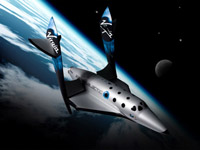SpaceShipTwo to Take the Lucky to the Stars
Finally, the spacecraft designed to fly several tourists at once into space, has been released. Though the dream stays a dream for many people as many years must pass before the tickets on it become affordable for mere citizens of U.S. and other countries.

The long-awaited glimpse of SpaceShipTwo, slated for rollout Monday in the Mojave Desert, could not come sooner for the scores of wannabe astronauts who have forked over part of their disposable income for the chance to float in zero gravity.
"We've all been patiently waiting to see exactly what the vehicle is going to look like," said Peter Cheney, a 63-year-old potential space tourist from Seattle who was among the first to sign up for suborbital space rides marketed by Virgin Galactic. "It would be nice to see it in the flesh."
Virgin Galactic spokeswoman Jackie McQuillan promised a "theatrical unveil" followed by a cocktail party for paying passengers and other VIPs.
SpaceShipTwo's debut marks the first public appearance of a commercial passenger spacecraft. The project is bankrolled by Virgin Galactic founder, British billionaire Sir Richard Branson, who partnered with famed aviation designer Burt Rutan, the brains behind the venture.
SpaceShipTwo is based on Rutan's design of a stubby white prototype called SpaceShipOne. In 2004, SpaceShipOne captured the $10 million Ansari X Prize by becoming the first privately manned craft to reach space.
Since the historic feat, engineers from Rutan's Scaled Composites LLC have been laboring in a Mojave hangar to commercialize the prototype in heavy secrecy.
The last time there was this level of hoopla in the high desert was a little more than a year ago when Branson and Rutan trotted out to great fanfare the twin-fuselage mothership, White Knight Two, that will ferry SpaceShipTwo to launch altitude.
Despite the hype, hard work lies ahead before space journeys could become as routine as air travel.
Flight testing of White Knight Two has been ongoing for the past year. The first SpaceShipTwo test flights are expected to start next year, with full-fledged space launches to its maximum altitude by or in 2011.
It remains unclear when Virgin Galactic customers will receive their astronaut wings, but it will largely depend on how the test program fares. Some 300 clients have paid the $200,000 ticket or placed a deposit, according to the company.
SpaceShipTwo, built from lightweight composite materials and powered by a hybrid rocket motor, is similar to its prototype cousin with three exceptions. It's twice as large, measuring 60 feet long with a roomy cabin about the size of a Falcon 900 executive jet. It also has more windows including overhead portholes. While SpaceShipOne was designed for three people, SpaceShipTwo can carry six passengers and two pilots.
The ability to view Earth's curvature from space has been limited so far to government astronauts and a handful of wealthy people who have shelled out millions to board Russian rockets to the orbiting international space station.
After SpaceShipOne's history-making flights, many space advocates believed private companies would offer suborbital space joyrides before the end of this decade.
Virgin Galactic plans to operate commercial spaceflights out of a taxpayer-funded spaceport in New Mexico that is under construction. The 2 1/2 hour trips — up and down flights without circling the Earth — include about five minutes of weightlessness.
SpaceShipTwo will be carried aloft by White Knight Two and released at 50,000 feet. The craft's rocket engine then burns a combination of nitrous oxide and a rubber-based solid fuel to climb more than 65 miles above the Earth's surface.
After reaching the top of its trajectory, it will fall back into the atmosphere and glide to a landing like a normal airplane. Its descent is controlled by "feathering" its wings to maximize aerodynamic drag.
Virgin Galactic expects to spend more than $400 million for a fleet of five commercial spaceships and launch vehicles.
It's not the only player in the ultra-secretive commercial space race. A handful of entrepreneurs including Amazon.com Inc. Chief Executive Jeff Bezos, computer game programmer John Carmack and rocketeer Jeff Greason are building their own suborbital rockets with dreams of flying people out of the atmosphere.
CNBS has has contributed to the report.
Subscribe to Pravda.Ru Telegram channel, Facebook, RSS!


